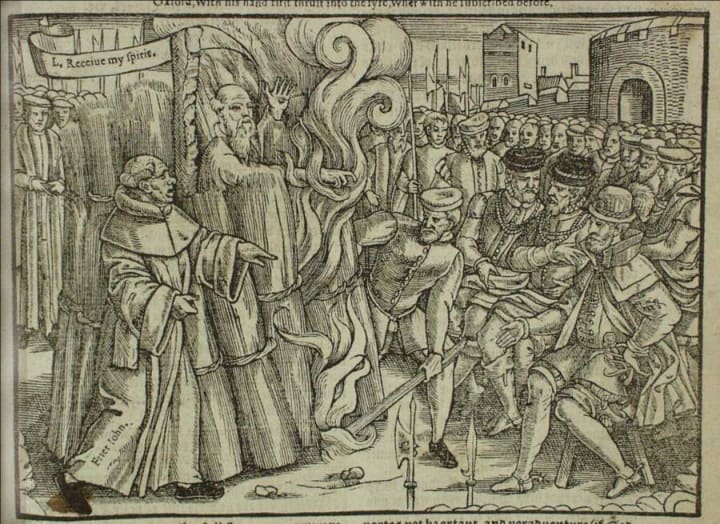
You may have been dared as a child to summon Bloody Mary. All you had to do was stand in a dimly lit bathroom and stare into the mirror, then chant her name 13 times... And if it went according to plan, a woman should appear in your mirror. Sometimes she wouldn't be alone and would hold a dead baby, other times she would be alone. And as the legend states, she would do nothing but stare. But, on occasion, it is said that she will leap from the glass and scratched or kill the one that summoned her.
Was Bloody Mary based on a real person?
The Bloody Mary tale may be fabricated, but there are possible figures throughout history that might be the "real" Bloody Mary. They include Queen Mary I of England, who has been called by the name Bloody Mary for centuries, as well as a Hungarian noblewoman and an evil witch who murdered children.
The Real Bloody Mary

It is believed that the Bloody Mary legend is tied to the queen who bore the same nickname. She became known as Bloody Mary because she burned about 280 Protestants alive during her time as Queen.
She was born on February 18th, 1516, in the Greenwich Palace in London, England, to Henry VII and Catherine of Aragon. Mary didn't seem like a likely candidate to be queen, her father deeply desired a male heir and he spent Mary's childhood doing whatever he could to get that male heir.
Mary's early years were defined by her fathers determination to have a son. When she was a teen, the king scandalized Europe by declaring his marriage to her mother illegal and incestuous, this was because she had been briefly married to his brother, and he wished to marry Anne Boleyn. She then divorced Catherine, married Anne and ripped England away from the Catholic Church, he then went on to established the Church of England instead.
Mary was then declared illegitimate, and thus was made a "lady" instead of her previous title as a "princess" and she was separated from her mother. She refused to acknowledge her parents' marriage was made illegal or that her father was the head of the church.
Mary watched as her father married again and a again. After the execution of Anne Boleyn, he went on to marry Jane Seymour, who passed away during childbirth. His fourth marriage was to Anne of Cleves, it ended in divorce shortly after the union, he executed his fifth wife, Catherine Howard, on some trumped-up charges. His sixth wife, Catherine Parr, was the only one to outlive him. But, he managed to get what he wished for. Jane Seymour had a son, Edward VI.
However, Edward VI died only six years into his reign, he attempted to ensure that power was passed on to his Protestant cousin, Lady Jane Gray. But, Mary managed to seize her opportunity and led an army to London in 1553. She was put on the throne due to support and Lady Jane Gray was put on the executioner's block. It was as queen that Mary I got her reputation as "Bloody Mary."
The Queen's Story and How It Ties in to the Bloody Mary Legend
Mary's priorities as queen started with returning England to the Catholic Church. She married Philip II of Spain, she stopped a Protestant rebellion, and she even reversed many of her father and half-brother's anti-Catholic policies. In 1555, she took it all one step further by reviving the heretico comburendo law, this punished heretics by burning them at the stake.
Mary hoped that these executions would be shocking, and they would encourage Protestants to return to the Catholic Church. At first, she thought only a few executions would do the trick, she told her advisors that these should be "so used that the people might well perceive them not be condemned without just occasion, whereby they shall both understand the truth and beward to do the like."
But, the Protestants were undeterred, and for three years, from 1555 until Mary's death in 1558, she commanded almost 300 of them be burned alive. Some of the victims included religious figures like Thomas Cranmer, the archbishop of Canterbury, and bishops Hugh Latimer and Nicholas Ridley. As well as citizens, mostly those whom were poor.

John Foxe, a Protestant, recorded the deaths. In his 1563 book, The Actes and Monuments, also known as Foxe's Book of Martyrs, he described the deaths of the Protestant martyrs, all complete with illustrations.
Mary left a lasting legacy after her executions of Protestants, this earned her the nickname "Bloody Mary," but this isn't the only reason some believe that the Queen is linked to the legend.
The Tragic Pregnancy
It is told that Bloody Mary is accompanied by a baby or that she is searching for a baby. In some versions of the legends, those who summon her can taunt Bloody Mary saying, "I stole your baby," or "I killed your baby." And there is a reason for this.
Alongside her executions, Mary had another priority. That was to get pregnant. She was 37-years-old when she took power, and determined to get pregnant with an heir during her reign.
She announced her pregnancy two months after she had married Philip, and she appeared to be pregnant, but, her due date came and went without her giving birth.
Rumors spread in the French court that Mary had "been delivered of a mole, or a lump of flesh." It is possible that Mary had a molar pregnancy, a complication that is known as a hydatidiform mole.
Mary died in 1558 at the age of 42, possibly due to uterine or ovarian cancer, and she passed away without having a child. So, her Protestant half-sister, Elizabeth, now took power, this further cemented Protestantism's place in England.
Mary's enemies made sure that she would be known as "Bloody Mary." But, the Smithsonian notes that Mary's father executed as many as 72,000 of his subjects, and her sister would go on to hang, draw, and quarter 183 Catholics. But, Mary was the only one who was deemed "Bloody."
It is possible her reputation stemmed from sexism, or because she was a Catholic queen in a largely Protestant nation. But, either way, the nickname tied Mary to the legend. But, there a few other women that may have inspired the story.
Other Inspirations

There are two other women who some speculate inspired the Bloody Mary story. The first is Mary Worth, a mysterious witch, and the second is Elizabeth Bathory, who was a Hungarian noblewoman who allegedly murdered hundreds of girls and young women.
The details of Mary Worth's story are hazy, including whether or not she even existed. She is described as a witch who allegedly put children under a spell, kidnapped them, murdered them, and used the blood to stay youthful. Once people found out about her doings, they tied her to a stake and burned her alive. Mary Worth screamed that if they dared say her name in a mirror, she would come to haunt them.
However, the Lake County Journal, writes that Mary Worth was actually a local of Wadsworth, Illinois and that she was part of the "reverse underground railroad."
"She'd bring in slaves under false pretenses and send them back down south and make some money," Bob Jensen, paranormal investigator and leader of Lake County's Ghostland Society told the Lake County Journal.
He also went on to explain that Mary would also torture and kill escaped slaves as part of her "witchy" rituals. And eventually local townspeople heard about her rituals and killed her, either by burning her at the stake or lynching her.
While Mary Worth's existence is debatable, Elizabeth Bathory's was very real. She was a Hungarian Noblewoman who was charged with killing at least 80 girls and young women between 1590 and 1610. Rumors were spread that she would subject them to torture such as sewing their lips shut, beatings with clubs, and burns caused by hot irons. Allegedly, she would bathe in their blood in order to maintain a youthful appearance.
One witness claimed during Elizabeth's trail that they had seen a diary in which she recorded her victims. But there weren't 80 names on that list, instead it was 650 names. And for this reason, Elizabeth seems to be a fair inspiration for the Bloody Mary legend. But, with all that being said, defenders of Elizabeth say that the charges against her were fabricated because the king owed her late husband debts.
About the Creator
Shelby
Just a girl who loves to write about paranormal and life stuff. Please enjoy






Comments
There are no comments for this story
Be the first to respond and start the conversation.